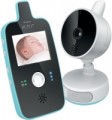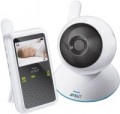—
Sensitivity adjustment. The ability to adjust the sensitivity of the microphone in the baby unit of the baby monitor. On the one hand, the parent needs to hear well what is happening with the child, on the other hand, a microphone set to the maximum can capture a huge amount of extra sounds, from the rustle of sheets to conversations outside the window. Adjustable microphone sensitivity provides an optimal balance between these extremes.
—
Night lamp. Possibility to use the child's baby monitor unit as a night lamp. Often children (especially those who have grown up) are afraid to fall asleep in complete darkness, and the light of a night lamp is able to drive away the fear of the dark and at the same time is not so bright as to prevent falling asleep. In baby monitors, turning on, off and adjusting the brightness of the night light can be done remotely from the parent unit, and in models with video, the lamp can be useful as a backlight if the camera does not have a night mode (see "Night vision").
—
Night vision. The ability to operate the camera on the baby unit of the baby monitor in night vision. This mode provides an unobstructed (but colorless) view of what is happening in the room, even in darkness where it is impossible to distinguish anything with the naked eye. Thus, you can see your baby on the baby monitor screen at any time, even at night,
...when he/she is sleeping and any light in the room is undesirable.
— Parent unit searching. The parent unit is a portable device and, like all such devices, is prone to getting lost. The search function makes it easier to detect the loss: when you press a button on the baby unit (which is usually permanently fixed in one place and does not go anywhere), a command is sent to the parent unit, and an audible alarm is triggered, which marks the location of the device.
— Temperature sensor. Thanks to this function, you will be able to monitor not only the baby, but also the conditions in his/her room. The temperature sensor monitors the air temperature in the child's room and transmits data to the parent unit. Some models may provide an alarm for a critical increase/decrease in temperature.
— Humidity sensor. Another sensor that monitors room conditions. In this case, humidity, which is as important to young children (and especially newborns) as temperature. For more information, see “Temperature Sensor".
— iOS compatible. Ability to use iPhone as a parent unit. Actually, some models with this function may not even have a parent unit — its role is played by a smartphone with the appropriate application installed. The connection can be made in different ways. Note that often we are talking about all Apple products.
— Android compatible. The possibility of the child unit working with smartphones and other gadgets (e.g. tablets) running Android. In this application, the gadget with a special application installed on it plays the role of a parental unit. In addition, some models with this function may not be equipped with a separate parental unit at all and can be connected only to a portable device.
— Video recording. Ability to record video broadcast by the baby monitor camera to the parent unit. In this case, it is assumed that the device itself is equipped with everything necessary and does not require the use of additional equipment (TVs, recorders, etc.). Recording is usually done on memory cards, often with the option of direct transfer to a computer hard disk, for example. Recordings from the baby monitor camera can be used as material for an amateur movie about your baby, to clarify the circumstances and take action in case of an unpleasant accident in which the baby was injured, etc.
— Photography. The ability to use the parent unit's camera to take photos — for example, if you want to remember a funny moment that fell into the camera lens, or vice versa, to record the circumstances of an unpleasant incident to clarify them and take action. The command to take a picture is given from the parental unit.
— Connection of additional cameras. Ability to connect additional cameras to the video baby monitor. This increases the possibilities of the device. For example, the main camera can be mounted above the crib and the additional camera can be mounted under the ceiling to provide a view of the entire room, so you don't have to worry about your baby getting out of the crib and out of sight of the main camera. Another option is to add a camera with night vision (see above) if the main camera does not have it, etc. In baby monitors, this feature provides the ability to connect multiple baby units, so you can monitor (hear) events in different rooms from one parent unit.
— Wall mount. Possibility of mounting the baby unit of the baby monitor with a camera on the wall. This feature provides additional options for installing a baby unit — for example, it can be useful if you don't like the crib-mounted option for some reason.
